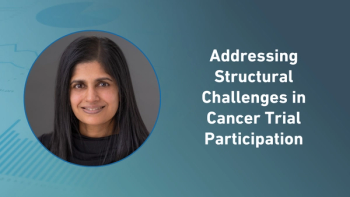
Precision Medicine Now and in the Future: Implications for Phase 1 Clinical Trials
The catalog of theranostic markers (TMs), which consists of biomarkers that help to identify patient populations best poised to respond favorably to a specific therapy, continues to expand.
The catalog of theranostic markers (TMs), which consists of biomarkers that help to identify patient populations best poised to respond favorably to a specific therapy, continues to expand. Historically, TMs have been limited in number and variety, but the burgeoning fields of genomics, proteomics, metabolomics, and exosomics, will add exponentially to the list of available TMs. Correspondingly, patient groups formerly belonging to a single diagnostic category for treatment purposes will be parsed into smaller and smaller subgroups based on TM signatures. This fragmentation will be for the best, since, for each TM-defined subcategory of a disease there will exist a given type of therapeutic intervention that may optimize the risk-benefit ratio for that patient.
A simple current example of the utility of a TM is the greater likelihood of tumor response to cetuximab in patients with colorectal cancer lacking the KRAS mutation. With time, panels of TMs that span the various –omics will splinter patients into progressively smaller categories. From a drug development standpoint, trial sample sizes required to demonstrate compelling evidence of marked benefit will decline, because the treatment delta, a prime determinant of study sample size, will be greater in carefully selected patients with a specific TM signature that bodes well for success. The challenge, of course, will be efficient recruitment of such subjects, particularly in Phase 1b studies where a single unit is often expected to carry the day, enrolling 20 or 30 patients.
Given current industry trends, with large CROs offering the ability to accrue healthy volunteers losing ground in the market to smaller centers with access to patients that allow pharmaceutical companies to risk-mitigate a program in FIH studies in patients, it is likely that the oncology model of drug development (i.e., “straight to patients”) will continue to make inroads in other therapeutic areas. If these patients are parsed into ever finer groups based on increasingly complex biomarker profiles, then the future is clear. Phase 1 clinical trial consortia will be needed to ensure that enrollment goals are met.
The National Cancer Institute has been in the vanguard, and its clinical trials network, enabling early phase studies in patients with various genomically characterized tumor types, sets the tone for the future. Major challenges, however, as this model matures, will be optimization of efficiency, quality, and assurances of patient safety in large multi-site FIH studies, where each site must behave as if it is physically adjacent to other sites, forming a linked organic whole that functions like a “Meta-Unit.” Technology must come to the rescue, and ideas for such IT innovations would form the basis for another blog. The nonprofit research institute to which I belong, SRI International, has broad strength in biomarkers and a state of the art Phase 1 clinical trials unit, yet no one will be able to go it alone in the era of hyper-personalized medicine. Ultimately, we will seek partners in forming a clinical research consortium to amplify upon what we can do now.
It is worth mentioning the effect a potential evolution in the role of a wholly different class of biomarkers, namely “response biomarkers” (RMs), may have for Phase 1 trials, again emphasizing the need for consortia. Phase 1b studies in patients tend to focus primarily on single response biomarkers, or short-term clinical endpoints” at a given point in time. For example, transaminase levels in patients with non-alcoholic steatohepatitis. An RM, once fully validated in the clinic, becomes a surrogate marker than can support accelerated regulatory approval (e.g., viral load), changes in the value of which have been unequivocally shown to be predictive of long-term clinical benefit. But, even in early development, before full clinical validation, one or several individually analyzed mechanistic or response biomarkers are frequently used to make programmatic go-no go decisions. Is there a way to increase the certainty with which the “right” decision is made? Perhaps. A systems biology-based approach may, one day, link the –omics, yielding “cross-omic” RM profiles that provide far greater assurances that the potential for a drug is accurately assessed in a Phase 1b study. In the future, network or flux analysis of these dynamic RM profiles in real-time could facilitate adaptive clinical trial designs and individualized dosing in Phase 1b that optimizes the chance of success. This will further subdivide patients (this time into RM profile categories), stressing the need for well-organized consortia to ensure adequate characterization of RM profiles, and how best to tailor dosing in a given subject. Again, tight coordination among participating sites in a virtual Phase 1 Meta-Unit, enabled by adequate IT infrastructure that unifies participating sites, will be of paramount importance if such a sophisticated approach is to practically succeed.
In summary, technology and personalized medicine should spur the formation of seamlessly integrated Phase 1 clinical trial networks, with centralized coordinating centers, that conduct studies in extensively biomarker-indexed patient subpopulations. Without these webs, the studies would be impossible, and opportunities to improve outcomes through development of highly personalized medicines would be unrealized. To borrow from the Tao-te Ching, one might say of a network of Phase 1 sites in multiple cities and patient catchment areas, “though its meshes are wide, it misses nothing.”
David Sahner, MD, is the senior director of Clinical Translation in SRI International’s Biosciences Division, where he provides strategic and tactical guidance to internal researchers and external clients.
Newsletter
Stay current in clinical research with Applied Clinical Trials, providing expert insights, regulatory updates, and practical strategies for successful clinical trial design and execution.




